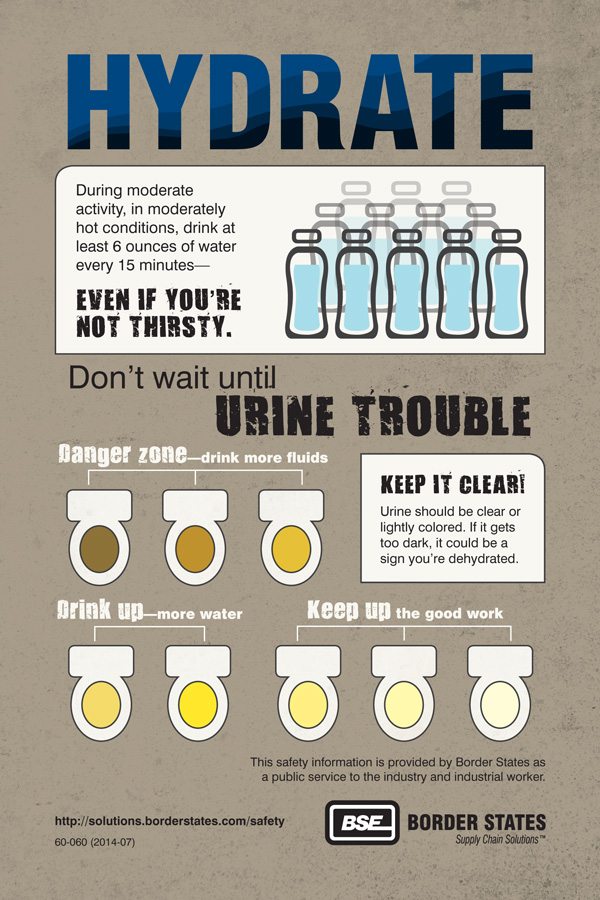Staying hydrated on the job is crucial to maintain worker health and safety, especially during extreme temperatures and in dry climates. When it’s hot out, your workers need to continuously replenish their fluids to ensure they’re healthy and stay productive.
According to the U.S. Occupational Safety and Health Administration, workers who are exposed to heat but fail to keep cool may develop heat-related illnesses that could endanger their health.
Workers who don’t have enough fluid intake may be unable to regulate their internal temperature, which could put them at risk for the deadliest form of heat illness—heat stroke.

Good hydration usually results in clear and copious urine.
Benefits of Drinking Water
Drinking a sufficient amount of water each day helps combat heat stress. Drinking enough water will make sure your crew members’ bodies function as optimally as they should.
Since the majority of blood and bone are made of water, some of the major benefits of staying hydrated are easy to guess. Consuming water is necessary to create new blood and bone cells.
Not only is water essential for creating new cells, but water also aids in joint lubrication to lower joint pain and damage.
Organ systems, such as the lymphatic system, benefit greatly from drinking water. The lymphatic system needs water to run and expel wastes and toxins from the body.
By properly hydrating, your workers can also make sure their brains and nervous systems function normally.
Tips to Stay Hydrated Throughout the Day
Drink a glass of water in the morning. Your workers should drink a glass of water before having their morning coffee or tea, which allows them to rehydrate after a night of not drinking water, according to Care2.
Rest and drink water during work. Taking water breaks could help make sure your workers replenish fluids that they lost during the workday. According to OSHA, stopping to rest and drink water is an effective way to prevent heat-related illnesses, giving the chance to cool down before beginning work again.
Provide your workers with water filters and bottles. Filters may encourage your crews to drink more liquids (based on preference).
How to Calculate Fluid Intake
Your workers may wonder how much fluid they need to stay healthy. While you may have heard of the recommended eight glasses of water each day, the right fluid intake depends on the individual worker.
Your crew members could calculate how much water they need to consume per day using a daily hydration calculator. This tool takes several calculations into consideration: weight, medical conditions and the climate of the job site.
Recognize Signs of Dehydration
In the event of an emergency, such as when workers are severely dehydrated, you may want to train employees to recognize signs of dehydration and heat-related illness to improve workplace safety and take action to help.
According to Medline Plus, the symptoms of dehydration may include having headaches and muscle cramps. Your workers may report they are thirsty or have a dry or sticky mouth.
When your employees are suffering from serious dehydration, they may exhibit signs of dry or shriveled skin. They may also have changes in behavior as they could become listless, irritable or confused.
If your workers have these symptoms of dehydration, Medline Plus encourages workers to sip water or suck on ice cubes to replenish their fluids. They may also want to drink water or sports drinks that have electrolytes to adequately refuel.
Border States Electric can deliver water to your job site, or you can pick it up at the City Desk, in order to meet OSHA requirement 1915.88(b)(2).